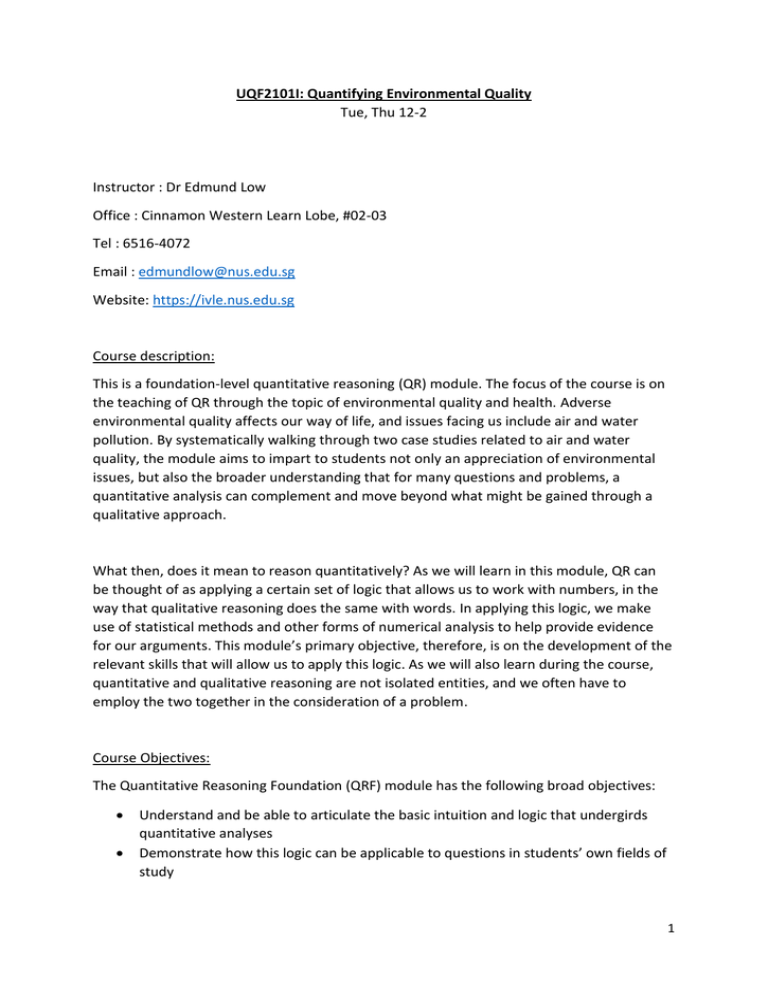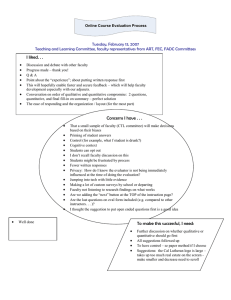UQF2101I: Quantifying Environmental Quality Tue, Thu 12-2
advertisement

UQF2101I: Quantifying Environmental Quality Tue, Thu 12-2 Instructor : Dr Edmund Low Office : Cinnamon Western Learn Lobe, #02-03 Tel : 6516-4072 Email : edmundlow@nus.edu.sg Website: https://ivle.nus.edu.sg Course description: This is a foundation-level quantitative reasoning (QR) module. The focus of the course is on the teaching of QR through the topic of environmental quality and health. Adverse environmental quality affects our way of life, and issues facing us include air and water pollution. By systematically walking through two case studies related to air and water quality, the module aims to impart to students not only an appreciation of environmental issues, but also the broader understanding that for many questions and problems, a quantitative analysis can complement and move beyond what might be gained through a qualitative approach. What then, does it mean to reason quantitatively? As we will learn in this module, QR can be thought of as applying a certain set of logic that allows us to work with numbers, in the way that qualitative reasoning does the same with words. In applying this logic, we make use of statistical methods and other forms of numerical analysis to help provide evidence for our arguments. This module’s primary objective, therefore, is on the development of the relevant skills that will allow us to apply this logic. As we will also learn during the course, quantitative and qualitative reasoning are not isolated entities, and we often have to employ the two together in the consideration of a problem. Course Objectives: The Quantitative Reasoning Foundation (QRF) module has the following broad objectives: Understand and be able to articulate the basic intuition and logic that undergirds quantitative analyses Demonstrate how this logic can be applicable to questions in students’ own fields of study 1 Become critical consumers of quantitative knowledge by being able to read, interpret, and think critically about the use of numbers in the material that we encounter everyday Discuss the purpose, strengths and weaknesses of quantitative analyses, both in the abstract, and in the consideration of any particular phenomenon, issue or question More specifically, upon completion of this QRF, students should be able to: Name the steps of the Scientific Method as it applies to quantitative research, describe the relevant tasks associated with each step, and be able to perform these tasks correctly Have a particular awareness of (1) the role that theoretical concepts and their empirical operationalization play in the research process; and (2) the importance of “falsifiability” Be able to: (1) build datasets by gathering and organizing numerical data; (2) compute basic descriptive statistics; (3) perform basic statistical analyses (e.g. linear regression; and (4) interpret the analysis results Have familiarity with the concept of “significance”, in the statistical sense, and be able to explain why it is central to the very notion of quantitative reasoning Know the criteria air pollutants and key indicators of beach water pollution Be familiar with how air quality and beach water quality are quantified Online resources for topics on air and beach water quality that will be covered in the module can be found at the following websites: Haze microsite: www.haze.gov.sg Recreational water quality: http://app2.nea.gov.sg/anti-pollution-radiationprotection/water-pollution-control/recreational-water-quality Hong Kong EPD beach water quality: http://www.beachwq.gov.hk/en/index.aspx Course Assessments: Class participation (10%) Tests: (40%) Group Project (30%) Individual Report (20%) 2 Course Outline: Week 1 2 3 4 5 6 7 8 9 10 11 12 13 Topic Introduction to QR, key environmental concepts The scientific method: How we approach a problem quantitatively and go about collecting data for our variables How does our data “look”: Visualisation methods and basic statistics Looking at the variability in our data: Probability distributions Basics of using our sample: Central Limit Theorem and assumptions of independence and normality Using our sample to infer what we want to know: sampling distributions, point and interval estimates Recess Are the findings from our sample “significant”: Hypothesis testing Modeling the relationship between our variables: Simple linear regression (I) Modeling the relationship between our variables: Simple linear regression (II) Adding more variables in our model: Multiple linear regression Reflecting on QR: What assumptions have we made and are they valid? Qualitative vs quantitative reasoning Project presentations Module review Assessments Test #1 (material Wks 1 – 4) Test #2 (material Wks 5 – 8) Individual report due Details on assessments: (1) Homework assignments will be given almost every week (usually on Thursdays) to reinforce the material covered during the week’s classes. We will discuss the assignments in class the following week. Discussion of homework assignments, along with contributions to class assignments and discussions, will go towards the class participation portion of your grade. (2) Two in-class tests will be given during the course of the semester, contributing 20% of the grade each. The tests are tentatively scheduled for the Tuesday of Week 6, (covering material from Weeks 1 – 4), and the Tuesday of Week 10 (covering material from Weeks 5 – 8). (3) Students will have to complete a group project (4 – 5 members per group) culminating in a presentation (30%) to be given in Week 12, and an individual report (20%) due at the end of class, Week 13. 3

